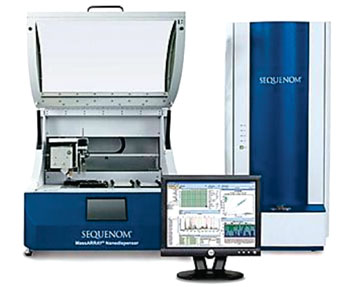Genes Identified That Increase Children's Risk Of Blood Infection
By LabMedica International staff writers
Posted on 16 Jun 2016
Bacteremia is a bacterial infection of the bloodstream, and a major cause of illness and death in sub-Saharan Africa but little is known about whether human genetics play a part.Posted on 16 Jun 2016
The leading bacterial cause of death in young children worldwide is Streptococcus pneumoniae or pneumococcus and 14.5 million episodes of serious pneumococcal disease occur in young children annually. Genes have been identified that make certain children more susceptible to invasive bacterial infections.

Image: The MassARRAY system for iPlex single nucleotide polymorphism (SNP) genotyping (Photo courtesy of Sequenom).
A global network of scientists coordinated from the Wellcome Trust Centre for Human Genetics (Oxford, UK), carried out a genome-wide association study to identify which genes might be associated with an increased likelihood of developing bacteremia. The study looked at DNA samples from more than 4,500 Kenyan children from the Kilifi area where there is a high occurrence of bacteremia. Just over 4,000 children were healthy, while slightly more than 500 had pneumococcal bacteremia.
Genomic DNA was extracted using the QIAamp DNA blood mini kit (QIAGEN, Hilden, Germany) and whole-genome amplified samples from case and control subjects were genotyped on the genome-wide Affymetrix SNP 6.0 chip (Affymetrix Inc, Santa Clara, CA, USA). Single nucleotide polymorphisms (SNP) in the additive or the genotypic model were directly genotyped in the discovery set to confirm imputation accuracy and in the replication sample set to confirm the associations using two iPLEX assays (Sequenom, San Diego, CA, USA). To quantify levels of long intergenic non-coding ribonucleic acid (RNA) expression, the teams performed quantitative real-time polymerase chain reaction (qPCR) using a relative quantification method.
The study found an area of two long intergenic noncoding RNA (lincRNA) genes that was associated with susceptibility to pneumococcal bacteremia. LincRNAs are RNA transcripts that are longer than 200 nucleotides but are not translated into proteins. LincRNAs are still little understood, although it is believed that the human genome has more than 10,000 of them.
Anna Rautanen, PhD, a senior author of the study, said, “'One of the associated lincRNA genes, called AC011288.2, is expressed only in neutrophils, cells that are known to have a key role in clearing pneumococcal disease. Critically, the genetic variants we have identified carry a doubled risk of developing bacteremia when infected with the Streptococcus pneumoniae bacteria. This discovery therefore provides clues in the pressing search for new ways to target the disease.” The study was published on June 2, 2016, in the American Journal of Human Genetics.
Related Links:
Wellcome Trust Centre for Human Genetics
QIAGEN
Affymetrix
Sequenom













